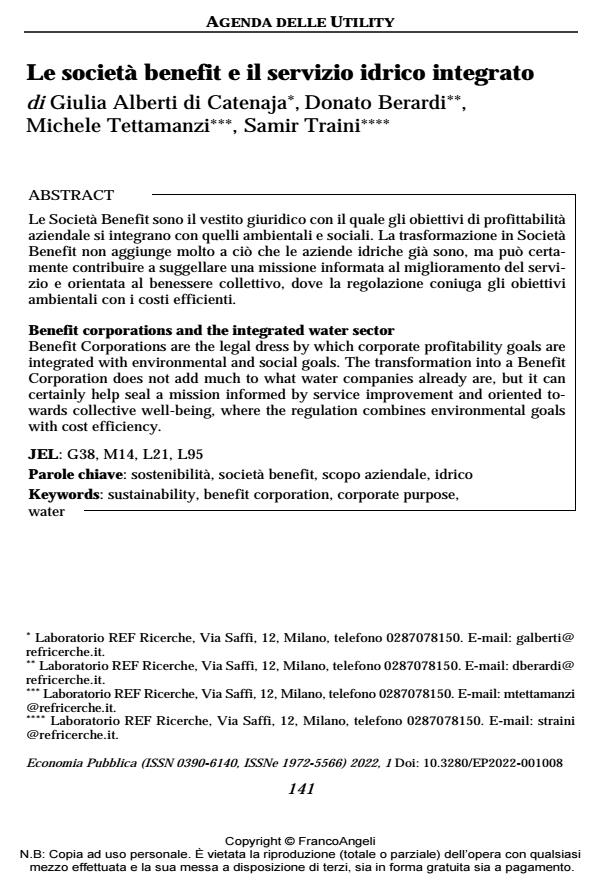Benefit corporations and the integrated water sector
Journal title ECONOMIA PUBBLICA
Author/s Giulia Alberti di Catenaja, Donato Berardi, Michele Tettamanzi, Samir Traini
Publishing Year 2022 Issue 2022/1 Language Italian
Pages 26 P. 141-166 File size 244 KB
DOI 10.3280/EP2022-001008
DOI is like a bar code for intellectual property: to have more infomation
click here
Below, you can see the article first page
If you want to buy this article in PDF format, you can do it, following the instructions to buy download credits

FrancoAngeli is member of Publishers International Linking Association, Inc (PILA), a not-for-profit association which run the CrossRef service enabling links to and from online scholarly content.
Benefit Corporations are the legal dress by which corporate profitability goals are integrated with environmental and social goals. The transformation into a Bene-fit Corporation does not add much to what water companies already are, but it can certainly help seal a mission informed by service improvement and oriented towards collective well-being, where the regulation combines environmental goals with cost efficiency.
Keywords: sustainability, benefit corporation, corporate purpose, water
Jel codes: G38, M14, L21, L95
- Assonime (2016). Circolare n. 19 del 20 giugno 2016. La disciplina delle società benefit.
- Bellavite Pellegrini C., Caruso R. (2020). Società Benefit. Profili giuridici ed economico-aziendali. Egea.
- Bellavite Pellegrini C., Seracini M. (2020). Società Benefit e aziende di servizio pubblico: perché il binomio è vincente. MF – Milano Finanza.
- Dowling W. (2018). The Business Case for Caring. B the change.
- Everett Craig R. (2013). Measuring the social responsibility discount for the cost of equity capital: evidence from benefit corporations. Journal of Behavioral Finance & Economics, 3(2).
- Fulton M., Kahn B., Sharples C. (2012). Sustainable Investing: Establishing Long-Term Value and Performance. Deutsche Bank Climate Change Advisors.
- GAIA S.p.A. (2020). Considerazioni sull’adozione da parte della società dello status di società benefit.
- Honeyman R. (2016). Il manuale delle B Corp. Bookabook.
- Ivanova A., Maher J., Marco G., Reinbold M. (2018). Moderating factors on the impact of B Corporation certification on purchasing intention, willingness to pay a price premium and consumer trust. Atlantic Marketing Journal, 7(2), Article 2.
- Kalfus L. (2019). The Business Case for the B Corporation Certification: An Empirical Study on the Relationship Between Social and Financial Performance. University of Michigan.
- Nigri G., Del Baldo M. (2018). Sustainability reporting and performance measurement systems: how do small-and medium-sized benefit corporations manage integration?. Sustainability, 10(12).
- Paelman V., Van Cauwenberge P., Vander Bauwhede H. (2020). Effect of B Corp certification on short-term growth: European evidence. Facoltà di Economics and Business Administration. Ghent University.
- Riva D. (2016). Le società Benefit. Feder Notizie – Notariato, Innovazione e Società.
- Romani F. (2021). Il futuro: la multiutility ridurrà l’impatto sociale e ambientale. Gazzetta di Mantova.
- Song S.Y., Kim Y.K. (2018). Theory of Virtue Ethics: Do Consumers’ Good Traits Predict Their Socially Responsible Consumption?. Journal of Business Ethics.
- Tettamanzi P. (marzo 2021). Società Benefit e B Corp con effetti su bilanci, reportistica e disclosure non finanziari. IPSOA.
- (2020) The B Book – il grande libro delle B Corp Italiane.
Giulia Alberti di Catenaja, Donato Berardi, Michele Tettamanzi, Samir Traini, Le società benefit e il servizio idrico integrato in "ECONOMIA PUBBLICA " 1/2022, pp 141-166, DOI: 10.3280/EP2022-001008